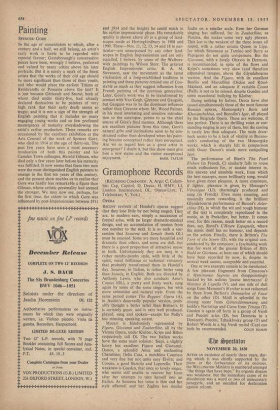PaintIng
SPENCER GORE
IN the age of romanticism to which, after a century and a half, we still belong, an artist's early work is liable to be regarded with especial favour; Gainsborough's conversation pieces have been, wrongly I believe, preferred and valued by many critics above his later portraits. But it is surely a mark of the finest artists that the works of their old age should be more significant than those of their youth, and who would place the • earliest Titians or Rembrandts or Poussins above the last? It is just because Gericault and Seurat, both of whom died under thirty-five, had already declared themselves to be painters of very high rank that their early death seems so tragic; and it is not a sign of the strength of English painting that it includes so many engaging young works and so few profound masterpieces of maturity overshadowing the artist's earlier production. These remarks are occasioned by the excellent exhibition at the Arts Council of the work of Spencer Gore, who died in 1914 at the age of thirty-six. The past few years have seen a most necessary revaluation of both this painter and his Camden Town colleague, Harold Gilman, who died only a few years later before his maturity was fulfilled. It now seems that these two men were the most distinguished English painters to emerge in the first ten years of this century. and the present show enables us to realise that' Gore was hardly less remarkable a figure than Gilman, whose artistic personality had seemed the stronger. We may now see, perhaps, for the first time, the extent to which Gore was influenced by post-Impressionism between 1911 and 1914 and the heights he could reach in his earlier impressionist phase. His remarkable quality is shown above all in a group of land- scapes made at Hertingfordbury in 1908 and 1909. These—Nos. I I, 12, 13, 14 and 18 in par- ticular—are unsurpassed by any other land- scapes in English Impressionism and are only equalled, I believe, by some of the Walbers- wick paintings by Wilson Steer. The greatest English Impressionist critic, R. A. M. Stevenson, saw the movement as the latest vitalisation of a long-established tradition in painting and these pictures remind one of Con- stable as much as they suggest influences from French painting of the previous generation. Later, Gore's work was to be transformed by contact with Van Gogh, cezanne and Gauguin, but Gauguin was to be the dominant influence rather than Cezanne whom Mr. Wood Palmer, in his most interesting and sensitive introduc- tion to the catalogue, points to as the chief source of Gore's final manner. Although there are excellent pictures from this time, Gore's natural gifts and inclinations seem to be con- strained rather than developed when hiepaint- ing became conceptual rather than perceptual. Are we to regard him as a great artist in emergence? I doubt it, but this show must give him a new status and the visitor exceptional










































































 Previous page
Previous page